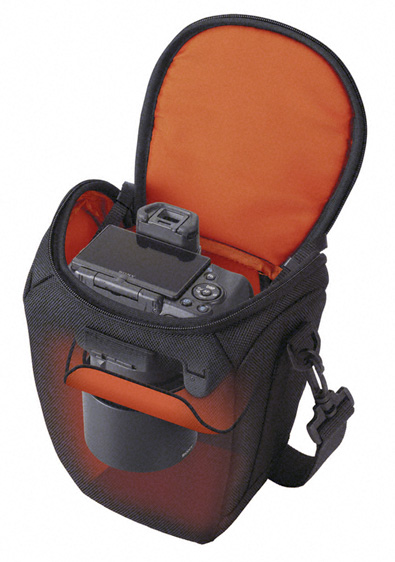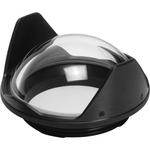New HVL-F43AM Alpha flash with rotating design
Sony has announced a new HVL-F43AM flashgun using the same type of rotating body design found in the top of the line HVL-F58AM, to replace the existing HVL-F42AM with its traditional bounce design. At the same time, some more Alpha system accessories have been rolled out.
HVL-F43AM ‘rotator’ flash

With a powerful output of GN43 (105mm ISO100 m), the compact yet versatile HVL-F43AM flash from Sony is optimised for superb results with all A-mount cameras.
As featured on the HVL-F58AM, the innovative Quick Shift Bounce system allows flash head position to be adjusted instantly when switching between horizontal and vertical compositions. This maintains consistent shadow positions regardless of camera orientation, allowing easy creation of natural-looking ‘bounce’ effects.
Smart flash functions open up even broader creative lightning possibilities. Wireless Ratio Control makes it easy to select light emission ratios for up to three separate flash units*. This allows quick creation of sophisticated multi-point lighting effects without the need for complex professional equipment.
Ideal for everyday shooting and more serious applications, its dust- and moisture-resistant design makes the HVL-F43AM ideal for demanding assignments, indoors or outside.
Flash power levels are switchable in 22 increments, from 1/1 through to 1/128 level in 1/3 steps. High output power is complemented by a quick 2.9 second (approx.) recycling time. Despite the flash’s extensive functions, operation is refreshingly clear and simple via the high-quality LCD screen and direction buttons.
Main specification for external flash HVL-F43AM
Guide Number – 43 (105mm, ISO100・m)
Flash Coverage – 24-105mm (15mm focal length covered with built-in wide panel)
Flash Control – Pre-flash control, manual flash control selectable, direct through-the-lens (TTL) flash metering
Bounce Flash – Click positions: up (30°/45°/60°/75°/90°/120°/150°); down (8°); right (30°/45°/60°/90°); left (30°/45°/60°/90°)
Recycling time (based on Sony measurement) – Approx. 2.9 seconds (with alkaline battery)
Battery performance (based on Sony measurement) – Approx. more than 200 flash cycles (with alkaline battery)
Power level switching – 22 levels: (1/1, 1/2, 1/4, 1/8, 1/16, 1/32, 1/64, 1/128), 1/3 steps
Wireless Ratio Control – Available to control by 3 groups when used with DSLR-A900/A850/A700
Other features
Auto WB Adjustment with Colour Temperature Info; Auto zoom control optimised for image sensor size; High-Speed Synchro; Modelling Lighting; Test Lighting; Multi Lighting. Supports camera’s Red-eye reduction feature. Built-in wide panel and bounce sheet. High quality LCD screen.
Compatible Shoe – Auto-lock Accessory Shoe
Included items – Mini-stand, Case
Dimensions (WxHxD) – Approx. 75 x 129 x 87 mm
Weight – Approx. 340g (without batteries)
Power source – Four AA-size cells of the same type, either alkaline or Ni-MH

VCT-55LH bracket
The VCT-55LH is a versatile mounting bracket that offers space for mounting additional ISO cold shoe accessories. A useful add-on for all A-mount cameras by Sony, the bracket can also be used with E-mount cameras such as the NEX-5, NEX-3 and the Handycam® NEX-VG10E HD camcorder.
Other accessories – like a shotgun microphone – can be securely mounted while the camera’s main shoe is occupied. The VCT-55LH is ideal for use with the CLM-V55 clip-on LCD monitor that offers a clear, high-resolution view of images during video and still shooting.

Soft Carrying Case LCS-AMB
The LCS-AMB carry case protects your A-mount camera and attached standard zoom lens while you’re travelling. A special suspended partition cradles the camera securely while allowing quick access. Finished in durable black polyester material, the case can be slung over a shoulder using the supplied strap, carried by the grab handle or attached to a belt. It also features handy pockets with space for up to two extra batteries, spare memory card and lens cap. (NB: Not compatible with DSLR-A900/A850).
Lens Hood ALC-SH111
Compatible with DT 35mm F1.8 SAM and 85mm F2.8 SAM lenses, this round-profile hood shades from direct sunlight to prevent glare and lens flare.
See all accessories by Sony for the α camera system here: www.sony.co.uk/hub/dslr/accessories
The new HVL-F43AM external flash, VCT-55LH bracket, LCS-AMB soft carrying case and ALC-SH111 lens hood for α cameras by Sony are available from Spring 2011.





